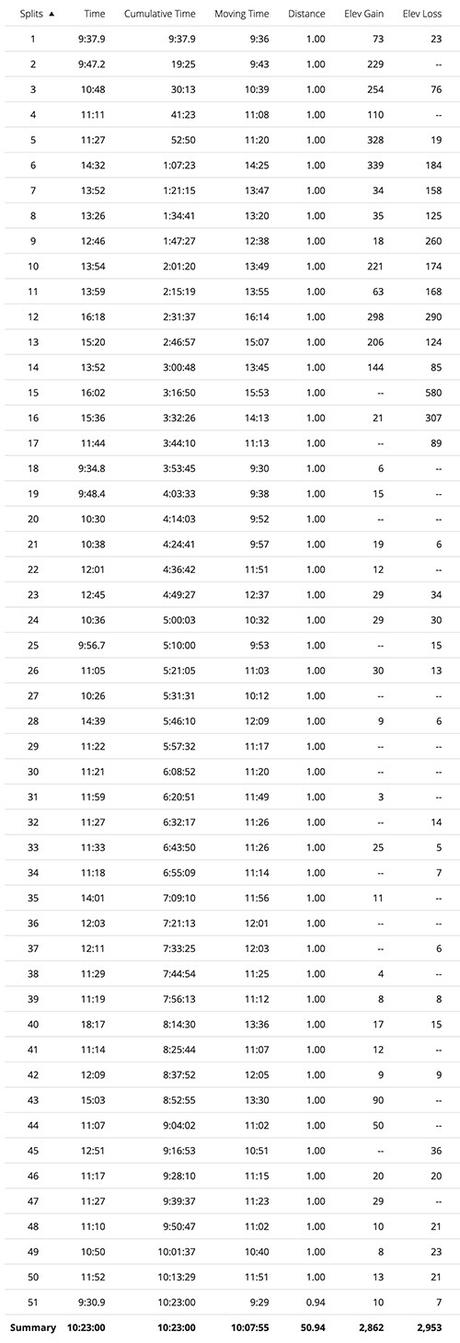Those who dare to fail miserably can achieve greatly.
– John F. Kennedy
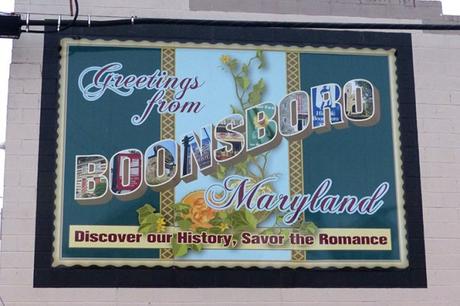
In 1908, a concerned President Theodore Roosevelt issued an executive order to address “the condition of utter physical worthlessness” that had befallen many of his fellow officers. Roosevelt’s order stated that officers of all military branches be able to complete “a march of 50 miles, to be made in three consecutive days and in a total of 20 hours, including rests, the march on any one day to be during consecutive hours.” Though the order met with some resistance, particularly from out-of-shape desk jockeys, others embraced the challenge, with some officers completing the 50-mile trek in a single day. Roosevelt was able to keep the directive in place during his administration, only to see it abandoned once he left office.
Fast forward 54 years to that same Oval Office but a different fitness-focused leader, our 35th President John F. Kennedy. In early 1963 Kennedy, himself a strong proponent of physical fitness, rediscovered Roosevelt’s order and shared it with U.S. Marine Commandant General David M. Shoup. Kennedy noted that the Marines in Roosevelt’s day had been able to complete the demanding 50-mile march in a single day, and he challenged Shoup to answer whether “the strength and stamina of the modern Marine is at least equivalent to that of his antecedents.” Kennedy, in turn, pledged to discover whether his own White House staff members were likewise up to the challenge.
Before Shoup could respond with a plan, U.S. Attorney General Robert F. Kennedy became the first to accept his brother’s challenge. Wearing leather oxford dress shoes (Blue Ribbon Sports, i.e. Nike, would not be founded until the next year), RFK set out early on the morning of February 9, slogging through snow and sub-freezing temperatures to complete the 50-mile distance in 17 hours 50 minutes. He covered the final 15 miles alone after the last of his aides dropped out at mile 35.
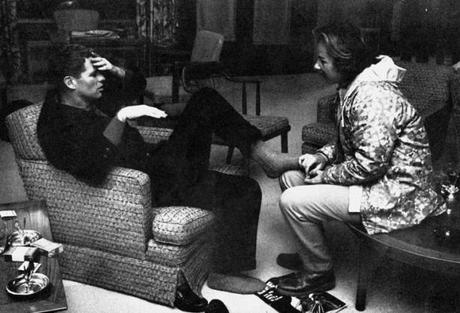
RFK gets a much-needed foot rub from his wife after his 50-mile trek (photo: Life Magazine)
Three days later, Shoup challenged several dozen of his officers to march 50 miles within 20 hours. Many of his Marines successfully (if begrudgingly) conquered the distance, with one second lieutenant completing the march in a speedy 9 hours 53 minutes. Soon, as media coverage of these feats by both RFK and the Marines spread, restless civilians eager to test their physical limits and acquire their own hard-earned blisters took up the gauntlet of their president’s “50 miles in 20 hours” challenge. And while some understandably failed, many others succeeded in impressive fashion. Said Dan Wulff, 17, of Morristown, NJ after completing the trek in 12 hours, 50 minutes in near-record cold: “It goes to prove we are in better shape than people think we are.”
The flame sparked by the “Kennedy Marches” continued to burn brightly through the winter and into the spring, before gradually waning and then fading almost entirely following the president’s assassination that November. Almost. Because while most of the JFK-inspired marches were canceled in the wake of his tragic death, one of the original marches held in the spring of 1963 was instead renamed by its founder (and one of its original four finishers), Buzz Sawyer of Maryland, who resolved to keep the tradition alive.
Thus was the JFK 50 Mile Challenge (re)born as the JFK 50 Mile Memorial. Fast forward another 56 years, and the JFK 50 Mile (as it’s simply known) in Washington County, MD now stands as the oldest ultramarathon race in the country as well as the only original JFK 50 Mile Challenge event still held annually.
Just think — over half a century after JFK made it his stated mission to make America fit again, our nation now boasts an obese, Diet Coke-swilling president who reportedly eschews exercise because he’s convinced it depletes the human body’s “finite” energy reserves. How’s that for progress?
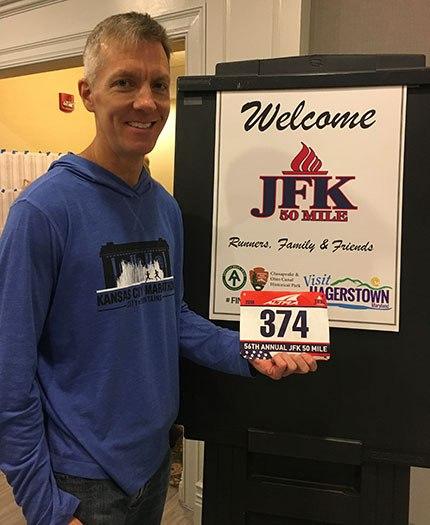
“Every accomplishment starts with the decision to try”
In a state of largely uninspiring marathons, the JFK 50 had emerged as the clear Maryland choice for my 50 States quest — in part because the chances of me not running the nation’s oldest ultramarathon, and especially one with such a cool back story, were as slim as an FDR dime. Not only that but the timing would be perfect, with race day falling five months after the 56-mile Comrades Marathon in South Africa and less than a month after back-to-back “training marathons” in Kansas City and Des Moines. So my muscle memory for 50-mile weekends would still be strong.
With 26 miles of the race course along the pancake-flat Chesapeake & Ohio (C&O) Canal Towpath, I even entertained the notion of chasing my 50+ mile personal record of 9:48:25, set five months early at Comrades — ironically the longest of my 50+ mile races.
The thing is, though, weather on the East Coast in mid-November can be pretty unpredictable — which is why I’m angling to run most of my East Coast races between April and October. And while I fully expected cold temperatures and even the potential for chilly rain, what I didn’t expect was that we’d be welcomed by snow on our 75-mile drive from Baltimore to Hagerstown.
A lot of snow.
Eight inches of snow.
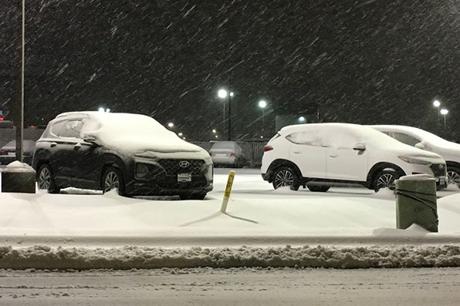
Ice to meet you: An early-season blizzard welcomed us to Washington County
Although record snowfall totals aren’t readily available for Washington County (‘cuz it’s out in the boonies), on the Thursday evening of our arrival Baltimore accumulated 1.7 inches of snow, eclipsing the old record of 1.2 inches set 110 years earlier — the same year President Teddy Roosevelt issued his “50 miles in 20 hours” directive. Oh, cruel irony…
As if that weren’t enough, 2018 had already been Maryland’s wettest year in recorded history, meaning that even without a slushy white overcoat the trails would be abundantly soggy. So this edition of the JFK 50 was shaping up to be more Tough Mudder than speedy ultramarathon — and eerily similar to RFK’s own winter trek 55 years earlier, minus the leather oxford dress shoes.
Fortunately, unlike Des Moines a month earlier, I’d come prepared for a sloppy cold weather run. And though the race day forecast called for overcast skies, temperatures would remain safely above freezing, meaning I could leave the tights in my suitcase.
And so, at 5:50am on the Saturday of my birthday weekend, I joined 850+ like-minded crazies for a pre-race briefing in the Boonsboro High School gym. Nothing says “happy 48th birthday” quite like playing in the mud all day. And unless it’s Bon Jovi’s Slippery When Wet, nothing whisks me back to adolescence quite like the distinctly nostalgic odor of a high school basketball gym. Put me in said gym with “Livin’ on a Prayer” blasting on the PA, and I may come out looking like the “before” model in a Clearasil ad.
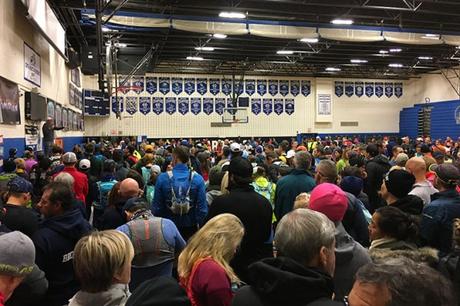
JFK 50 pre-race briefing or the most popular PTA meeting in America?
Race Director Mike (I presume, since I couldn’t hear his introduction) stepped up to the mic, welcomed us to the nation’s largest ultramarathon and confirmed that YES, the Appalachian Trail on which we’d run much of the first 16 miles would be a mess. And he applauded the race’s record number of female entrants, a commendable yet ironic fact given that I’d just been thinking on my walk into the gym how few women were in attendance. (Ultrarunning still has work to do before it can boast the equal or greater female representation of shorter distances.)
It’s funny to think of the JFK 50 as the largest ultramarathon in the United States when Comrades, the largest ultramarathon in the world, annually boasts roughly 20x the number of finishers. And I stand by my assertion that we really do need a Comrades-like event here in the States to rally around and call our own… but that’s a rant for another blog post.
Our fearless leader assured the room that back by popular demand would be the red velvet cake at the 38 Special aid station. As a biologist, I appreciate that everyone’s metabolism is different, and what works for one runner may backfire on another. But though I could not predict the next ten-ish hours, I could pretty much guarantee I wouldn’t be spiking my blood sugar & insulin levels at mile 38. Not if I wanted to reach the finish line in Williamsport on my own two feet.
Our emcee asked everyone to sit and then called on former and current military members to stand for applause. The JFK 50, he noted with pride, is first and foremost a military race (much like the Bataan Memorial Death March I’d run in March), and to this day the most prestigious prize remains the Kennedy Cup, which is awarded to the winning military team.
He also acknowledged veteran JFK 50 runners with varying (and in some cases staggering) numbers of finishes, recommending them as reliable pacers for anyone with a specific finish time goal. And he noted that “If you plan to finish in under nine hours, we consider you an elite athlete.” Then he offered one last motivational carrot to comfort the most anxious among us, announcing that the 2017 finisher rate had exceeded 95%.
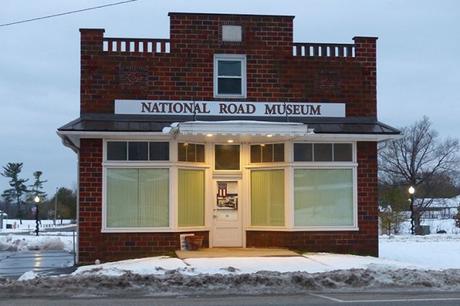
I’ve gotta believe a museum this size focuses on the roads less traveled
With that, class was dismissed, prompting the herd of warm bodies to migrate slowly out of the gym and into the predawn chill. Not surprisingly, I needed to heed the call of nature one last time, and I wasn’t the only one as evidenced by the queue for the relatively few porta-potties set up in the school parking lot. “It’s a 10-minute walk, so if you don’t leave now you’ll miss the start!” warned a voice behind us, though what could we do? It’s not like any of us were leisurely enjoying the cold discomfort of those dark, smelly plastic boxes.
And though I’d rather not have repeated my feat at January’s Houston Marathon where I’d (purposefully) been the second-to-last starter, I was comforted by the fact that this wasn’t Comrades, where gun time is the law of the land. Thanks to the timing chip attached to my bib number, I could start a couple of minutes late knowing that those 120 seconds wouldn’t count against my overall finish time.
Katie and I followed the shadows of the other runners out to Old National Pike, a two-lane road which even in the darkness was clearly the main thoroughfare in tiny Boonsboro, population 3,553. As we approached the hub of activity, a fellow walking toward us said, “Start your watches, the gun just fired and there’s no chip time at the start.” What?!? Are you KIDDING me? The race day instructions we’d received at packet pickup had noted in bold that “The race will start at 6:30am sharp,” without any mention of this key detail. So much for chip time.
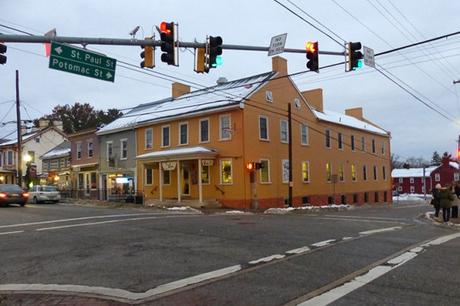
Bustling downtown Boonsboro, site of the JFK 50 start line
Granted, over the course of 50 miles two minutes likely means very little to a sub- (meaning “not”) elite runner like myself. And though I’m disciplined in my training, I’m not a Type A personality. That said, I could have done without this surprise shot of adrenaline to start the day. Quickly I started my Garmin, dropped to the curb, clumsily yanked off my wind pants and handed them to Katie, then took off running up the street.
We’d entered Old National Pike 300+ yards behind the start line and amazingly, by the time I reached it 93 seconds after the gun, the red-and-black Altra arch had already been deflated. In fact, I had to check the official race photos later that day to find evidence it had even existed. Did sleepy Boonsboro really need its main intersection back so promptly at 6:30am on a Saturday?
Note to the organizers: I appreciate you guys and everything you do to make this race happen 56 years running, but I hope you’ll consider starting (or ending) the pre-race briefing five minutes earlier, to allow everyone time to make a pit stop afterwards and still reach the start line by 6:30am. Given that we’re already starting (to quote a fellow poet from Tucson 2015) at the ass crack of dawn, what’s another five minutes?
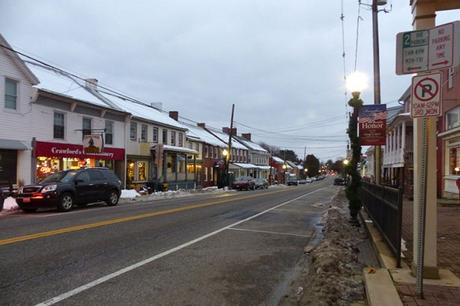
Mile 1 through Boonsboro, only 49 to go!
Glancing up the dusky road, I could barely make out the silhouettes of the back-of-the-pack starters receding in the distance. Knowing that 2½ miles of asphalt awaited before we reached the Appalachian Trail (AT), I relaxed and fell into an easy stride. My biggest concern with starting so far back was that I’d be among the last people to reach the AT and end up trapped behind hundreds of slower runners. Luckily the steady uphill climb made walkers of a lot of runners early and enabled me to pass plenty of them at a comfortable pace. This included my 50 States finisher buddy Meg who was starting slowly and smartly in this, her first 50-miler.
Apparently there were a couple of historic sites along this uphill climb, including the original Washington Monument (completed in 1827) somewhere off to our left. Essentially, though, all that was visible in daybreak’s snow-covered opening act were the uniformly brown skeletons of dormant trees, the occasional rural homestead and the double yellow line we now followed ever upward.
The initial stretch of the Appalachian Trail (AT) was more like “AT lite,” lasting only a mile on relatively flat terrain before returning us to the road for what seemed like another interminable ascent to the trail’s next segment. Slope notwithstanding, these two uphill miles were possibly the most peaceful of the day. The morning breeze animated the otherwise lifeless trees, blowing ice from their branches which then cascaded to the asphalt like glass from a shattered window. Luckily, despite the frozen landscape neither the wind nor weather would be a factor on this day, although the steely gray clouds would prevent our enjoying what I’d read was a beautiful sunrise along this stretch. Alas.
As we worked our way upward in the diffuse morning light, the wintry scene called to mind the memorable refrain penned by one of New England’s favorite sons, Robert Frost:
The woods are lovely, dark and deep, But I have promises to keep, And miles to go before I sleep, And miles to go before I sleep.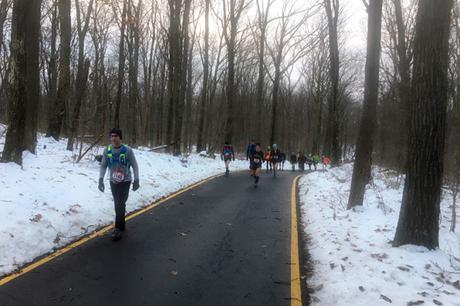
Ask not what Mother Nature can do for you…
Reaching the high point of the course (1,750 ft) and having already climbed over 1,200 feet to get there, we entered the much-anticipated second leg of the Appalachian Trail. And it was as good as advertised — but here let me hand the narrative reins over to someone with a broader perspective than a novice JFKer like myself:
I was very fortunate to notch my 31st JFK 50 mile finish yesterday. Trail conditions were the worst ever. Six time champion and fellow 31 time finisher Carolyn Showalter summed it up best in one word: horrendous!
– Dave Janosko, posting on the JFK 50 Facebook page
No argument from me — the next ten miles were hands down (and heads up!) the worst terrain I’ve ever run. This stretch was even slower than the highly technical Tecumseh Trail in Indiana, thanks to the dangerous combination of mud + snow = gooey slush that covered (and in some cases concealed) plenty of rocks, thick roots & discarded branches. Still harboring vivid (and painful) memories of a wrenched rotator cuff and bruised rib sustained at the Run Rabbit Run 50 Miler a year earlier, I’d already planned to approach this stretch with caution, and the conditions only slowed me further.
The rolling terrain didn’t help matters. I didn’t mind the ups so much because there’s better body control and less chance of slipping while climbing, but the downs were both mentally and physically demanding — and especially with other reckless runners flying by me occasionally on one side or the other, sometimes without warning.
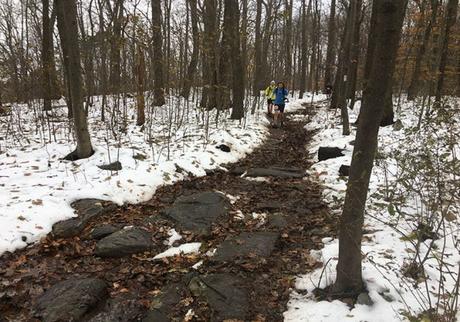
Now imagine 10 miles of this
At other times — and this is a trail-running pet peeve of mine — someone would trail close behind on my tail, a disregard for personal space that makes me irritable and anxious in the best of circumstances. And this certainly wasn’t those. If I’m going too slow, just say so and I’ll gladly step aside. On the other hand, if you like my pace and want to follow me, then allowing ten yards between us won’t limit your ability to do so. With the entirety of my focus already trained on not face-planting in the mud, this inexplicable “run in the leader’s back pocket” mindset did little more than stress me out and detract from my enjoyment of running on one of the nation’s most iconic trails.
Without pause my eyes scanned the trail, feeding my brain the constant stream of data it needed to spatially map out the next three steps in advance, a necessity on trails and especially highly technical ones. Every step seemed muddier than the last and presented a new opportunity to lose focus, slip on a large rock or root and take a hard fall. Often, presented with no clear option I’d intentionally step on a slick rock or gnarly wet root or in a muddy hole, taking care as much as possible with the angle of my landing. Maybe I could have moved faster, but in those conditions my 13+ minute/mile pace was already feeling Boston Qualifer-speedy. And odds were good that in short order I’d lose my footing, kiss the ground and come up looking (at best) like a summertime pig.
No, I was quite happy with my pace.
I heard one woman call the snow a “blessing” since it hid the rocks. Yeah, right, in much the same way tomato sauce hides whatever it was you just accidentally cracked a tooth on while biting into your pizza. In reality the snow made the otherwise navigable rocks incredibly slick. Maybe, six years later, this was the delayed payback for my dumb luck in tackling the slickrock of Moab on a fortuitously dry November day.
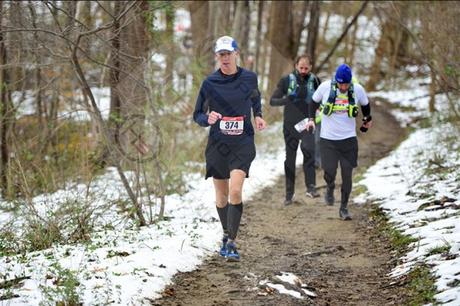
A relatively smooth stretch of the Appalachian Trail (photo: H3 Photography)
The farther we ran, the more treacherous the footing and the slower my pace. In several places I found myself taking the path of least resistance through ankle-deep mud, checking after every loud {slurp} that I’d successfully extracted my foot with shoe still attached. That for me spelled victory — that and remaining upright, unlike a couple of my less fortunate compatriots who lost their balance only to bounce right back up again and continue on their way, their egos more bruised then their bodies.
But how was the scenery along the historic Appalachian Trail, you ask? Honestly I have no idea. The couple of times I did glance up to catch my breath, all I saw was more snow and naked monochromatic trees. I’d been excited to take my first-ever steps on the AT, and something told me I’d need a return visit to better appreciate its scenic side.
All the high-stepping — over rocks, over roots, over tree branches — coupled with the added effort required to lift my feet out of their sticky, muddy footprints sapped the strength from my quads, so that by the time we reached the end of the AT my legs were pretty much toast. Mentally and physically, I was drained.
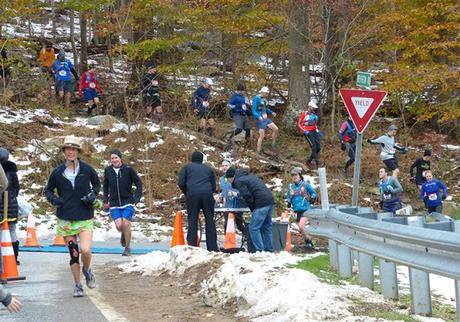
A caravan of runners exits the Appalachian Trail down Weverton Cliffs
At long last, though, we did reach the end, and a fitting end it was as the final 1,000 yards led us in caravan-style down Weverton Cliffs to where throngs of spectators (Katie included) cheered our arrival. The silver lining to the previous ten grueling miles was that by the time we reached the Cliffs the steep, slow and slippery descent didn’t feel nearly as treacherous as we’d been led to believe. A black-and-gold “DO NOT CROSS” ribbon lined one side of the descent, reminding runners to stay on the trail to prevent erosion. My immediate impression was of police tape at a crime scene, and I half-expected to look down and see a chalk outline where a fellow runner, desperate to escape the AT, had taken the descent a bit too recklessly.
By the time my feet touched the asphalt, I was so done with the Appalachian Trail — as were my toes, which had lost all sensation about five miles earlier. I found a bundled-up Katie waiting with dry shoes and socks for my hard-working feet, plus baby food for the rest of me. Quickly I downed a pouch of baby food — unlike my previous four 50+ milers, I’d wisely chosen not to carry a bag — and changed into new socks along with my road shoes for the remaining 34+ miles.
Happiness is a warm, dry pair of socks.
Bidding Katie farewell (for now) I got to my feet and set out again, only to realize within a few steps that we still had roughly ¼ mile of muddy trail left before joining the C&O Canal Towpath. Luckily that ¼ mile was more runnable and less sloppy than the previous ten, so I managed to reach the aid station and the Towpath just beyond that with relatively dry feet. But how naïve of me to think they would stay that way.
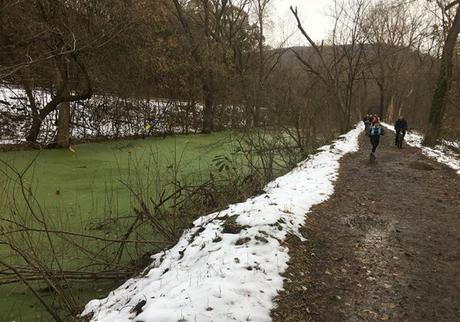
The initial stretch of the C&O Canal Towpath, looking like the Hulk bathed in the canal
“If we are strong, our strength will speak for itself. If we are weak, words will be of no help.”
After the bucking bronco of the Appalachian Trail, the C&O Towpath felt like riding atop Secretariat. Setting off briskly, I soon realized my 9:30-9:45 minute/mile pace would be unsustainable, and so was forced to pull back on the reins or risk reducing myself to a fast walk.
And the last thing I wanted at mile 16 was to slow down. Because for the next 26 miles we would be running on the sinuous edge of Maryland along the leafy, muddy, ne’er changing Towpath. Flowing alongside us to our left, the swiftly moving waters of the Potomac River provided relentlessly steady companionship. A few hundred yards across the river in Virginia, the scene looked much the same as on our side — stretches of bare brown trees stood guarding the border like naked, unmoving sentries. Two miles later Virginia became West Virginia, a nondescript changing of the guard that passed without warning or fanfare.
Every so often a bridge carrying traffic across the Potomac would pass overhead, but other than that the C&O Towpath was, as one RaceRaves reviewer described it, very much like Groundhog Day. Though serene enough, the early winter scenery was most memorable for its unapologetic uniformity, and it occurred to me that this could well be Mother Nature’s version of a treadmill.
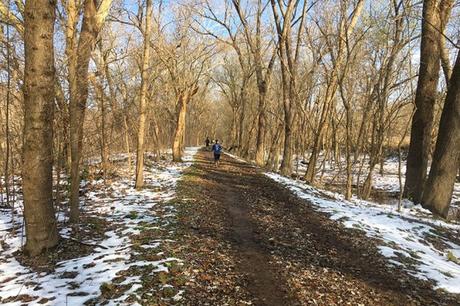
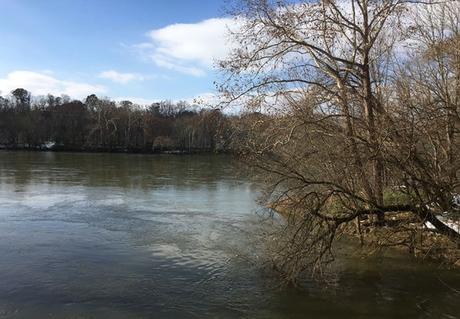
These two photos represent 26 miles of scenery, with West Virginia visible across the Potomac
Somewhere across the river in West Virginia sat Harpers Ferry, the northernmost point of Confederate-controlled territory during the Civil War, while several miles away on the Maryland side of the border lay Antietam National Battleground, site of the bloodiest battle in American history after which President Lincoln issued his Emancipation Proclamation. And running right through the middle of all this, I was able to appreciate none of it.
Because this, in a nutshell, is the unfulfilled promise of the JFK 50 course — as a runner you’re literally running through our nation’s history while being completely oblivious to it. Despite its historic Civil War surroundings (many indicated on the race website), our route on the C&O Canal Towpath would follow a stretch of 26 miles in which every mile looked nearly identical to the mile before and after it.
Every ultramarathon — and especially the 50+ milers — has its emotional ebbs and flows, including stretches where I simply tire of running and think, “OK, I’m good, I could happily call it quits now.” But I’m not sure — aside from Tucson three years earlier — that I’d ever been really, truly bored during a race like I was on the C&O Canal Towpath. Certainly the leaden state of my quads didn’t help. Adding to my ennui, personal listening devices were prohibited here at the one race where I might actually have turned to music or podcasts to keep my mind engaged.
The miles crept by like the drip, drip, drip of a slowly leaking faucet, so many muddy miles all blending together one after another after another. I tried to focus, to keep my legs churning and the odometer rolling. Mile 23, 24, 25, 26…
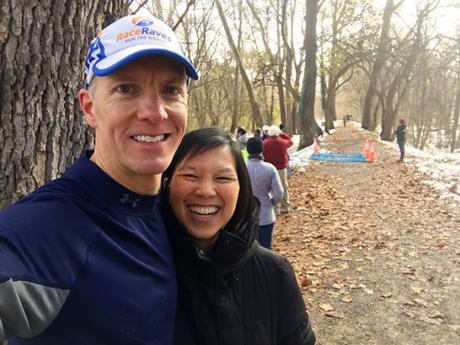
There’s never a bad time for a Katie sighting
Finally, in mile 28 at the Antietam Aid Station, another Katie sighting — my reward for reaching the halfway point. Unfortunately my joy was short-lived as, after noshing on a pb&j sandwich and doing a few knee lifts to loosen my battered quads, I took a few deep breaths and continued on my way. Immediately I looked forward to seeing her again at mile 38.
Over the course of the day I was overtaken by a number of runners; only one, though, stood out for the prosthetic running blade he wore below his right knee. As an Air Force explosive ordnance disposal technician, Adam Popp had been critically injured in Afghanistan in 2007, losing his leg and sustaining traumatic brain injury. Now here he was chasing his second consecutive JFK 50 finish, a stunning feat — I’d barely survived the Appalachian Trail on my own two legs! — and one he’d accomplish in an amazing 9 hours, 34 minutes, 29 seconds. Talk about grit. Much respect, Adam!
Though the flat, hard-packed Towpath was a high school track compared to the Appalachian Trail, it too had absorbed more than its share of rainfall, and in several stretches every step remained an adventure. My foot would slide forward or sideways or even backwards on the muddy trail, the ground working to siphon my remaining energy through the soles of my shoes. As messy as the Towpath was, though, we runners all owe a debt of gratitude to the selfless volunteers who apparently cleared it of large debris the day before the race. Huge thanks to those valiant souls for making a tough situation a bit more manageable.
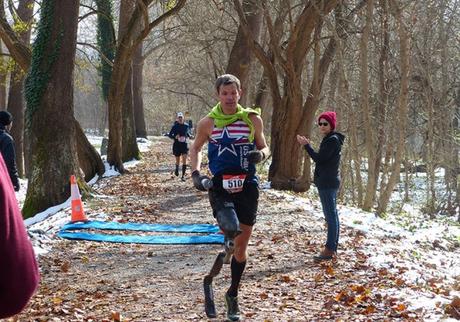
Trailing the unbreakable Adam Popp at the Antietam Aid Station, mile 28
The miles clicked by — 32, 33, 34, 35, the Potomac our constant if inscrutable companion. Glancing across at West Virginia, I silently promised that I’d return soon for a proper introduction.
Somewhere along this stretch an enormous tree had fallen across the trall, and I expended more energy than I would have liked climbing over its massive trunk.
Aside from aid station stops, I motored along at a fairly consistent 11+ minute/mile pace. But the aid stations were my lifelines, and none more so than the 38 Special (which I actually reached in mile 40). Here I met Katie one last time and then sat briefly to rest my legs, refuel my body and gather my wits for the final 10+ mile push.
The 38 Special aid station featured Christmas cookies, Santa Claus himself and YES, as promised the red velvet cake heard ‘round the world. Likewise as promised, the mere thought of red velvet cake at that moment made my head and stomach spin with nausea.
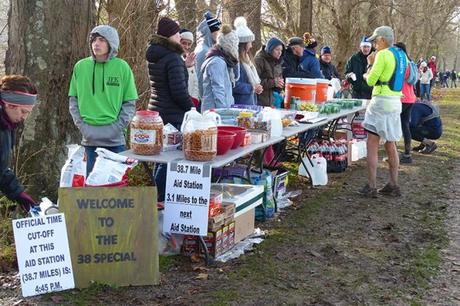
The 38 Special Aid Station
That said, all of the aid station volunteers were simply amazing — always upbeat, always helpful, and always responsive with everything from an easy smile to your favorite aid station snack to just about any other extemporaneous request, within reason. The volunteers collectively were a highlight of the day, and I’m grateful I didn’t have to endure the endless monotony of the Towpath without them.
JFK himself once said, ““We must find time to stop and thank the people who make a difference in our lives.” On race day, the JFK 50 volunteers made a huge difference in every runner’s life.
With what can only be described as grudging acceptance, I forced myself up out of my new favorite chair, told Katie I’d see her at the finish and set out, motivated by my desire to reach the end of the C&O Canal Towpath as quickly as possible — which under the circumstances, would not be quick at all. But as I left the 38 Special in my rearview mirror, I missed what would soon earn its place among our most amusing Maryland moments.
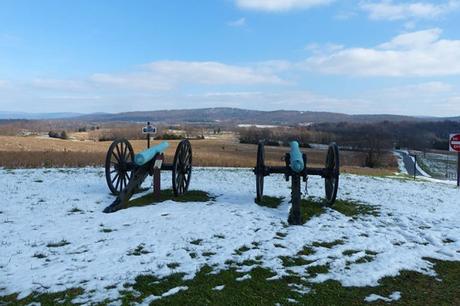
Between crewing & spectating stops, Katie happened upon Antietam National Battlefield
Anticipating my needs and then some, Katie had met me at the 38 Special aid station carrying a duffel packed with gear and supplies. After we parted ways and still carrying the duffel, she tried to shortcut her way back to her car by scrambling down the embankment that separated the course from her vehicle, only to end up losing her balance and toppling in the mud. So even though I was the one who ran 11 miles on the slimy Appalachian Trail and another 26 on the slippy slidey Towpath, guess which of us ended up taking home more souvenir JFK 50 mud at the end of the day?
Katie’s clearly one tough mudder.
By this time, my brain was anticipating mile 42 with the same single-minded zeal it normally reserves for finish lines. And at long last my diligence was rewarded as I crossed the final muddy timing mat of the day to signal the end of the C&O Canal Towpath. But the Towpath wouldn’t have been the Towpath without one last swath of sticky mud to circumvent as if to say, “Thanks for coming, sorry you can’t stay.” If Mother Nature could talk, I’m guessing the Towpath would have a sardonic sense of humor.
And I was so over it.
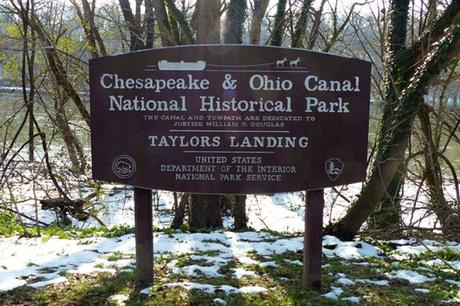
“We have come too far, we have sacrificed too much, to disdain the future now.”
Tentatively I tested my legs on the reliably unyielding asphalt as a volunteer wrapped a reflective armband around my biceps, an indication sunset wasn’t that far away. Then, as if to remind us all that the world’s not flat, the course jagged immediately uphill for a slow ¾ mile before leveling out on its final approach toward Williamsport.
Staying to the left at all times while traffic zoomed by a safe distance to our right, the last eight miles led us for the most part along rolling country roads. And if not for my eagerness to be done, I would have genuinely savored the wide-open expanses of rustic Northern Maryland.

Mile 44, with nothing but open sky and open roads ahead
Few of my fellow runners seemed to be in a hurry, the exception being a swiftly moving woman who, after leapfrogging me a couple of times, passed one final time while telling me, “Don’t worry, you’ll catch me soon.” With that, she turned on the afterburners and disappeared into the distance. Needless to say, I didn’t see her again.
For the first time mile markers appeared along the side of the road, more slowly than I would have liked but reminiscent of Comrades in that these counted down the distance to go rather than counting up the distance already run. This was a nice touch and especially once we passed five miles to go.
Abbreviated stops at the final two aid stations gave my legs just enough oomph for one last push. The Saturday sounds of college football on the radio greeted us at the mile 45 aid station, where friendly volunteers chatted excitedly as a mediocre University of Maryland football team gave a highly ranked Ohio State squad all it could handle. And at the mile 48 aid station I stopped just long enough for a few quick knee lifts and to text Katie my location — I wanted her to know my timing, since I was hoping she’d opted to wait inside the warm school adjacent to the finish line.
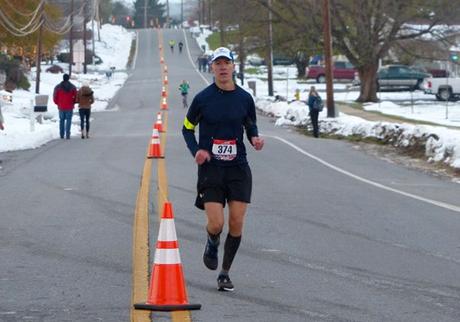
Mile 50 of the JFK 50, aka The End
I knew I’d reached the home stretch when I crested East Sunset Ave and saw the widely spaced orange pylons lining the center of the road. With every step I focused all my energy on reaching the next pylon, the booming voice of the PA announcer guiding me home until finally the long-awaited black-and-red finish arch came into view. Throwing out my arms to hug the sky, I high-fived the welcoming spirits of our 35th president and his strong-willed brother as I stopped the clock on my own Kennedy March in an official time of 10:24:33.
As challenging as the past 10½ hours had been, I couldn’t imagine walking a mile — much less 50 — on the Appalachian Trail in RFK’s leather oxford dress shoes.
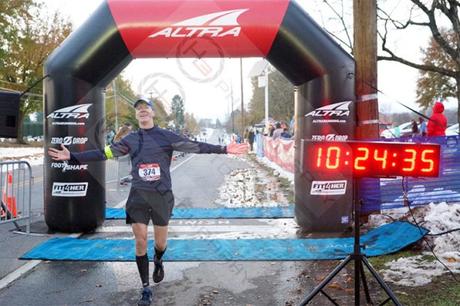
‘Scuse me while I kiss the sky (photo: H3 Photography)
“If not us, who? If not now, when?”
With gratitude beyond words I accepted my silver finisher’s medal and threw my arms around Katie for an extended embrace, before turning back to the finish to await our friend Meg’s arrival. Luckily we didn’t have long to wait as she crossed the line still looking strong in just seconds over her 10½ hour time goal, an impressive finish in her first 50-miler and especially given the conditions.
Then we all retreated to the Springfield Middle School cafeteria to warm up, change clothes and hopefully find something my stomach could digest. The setting sun reminded me that I’d just spent the entire day, sun up to sundown, running across Washington County.
Unlike previous 50-milers, this time I was able to find post-race comfort in sitting (progress!). And so I sat, for a long time letting the heat of the bustling cafeteria together with my own triumphant glow warm me. As a vegetarian the warmth was better than the post-race food, though dietary preferences aside the culinary options were well above average and included chili (served as a chili cheese dog or Sloppy Joe), pizza and — what else? — red velvet cake.
Meg and I compared notes and medals, the latter of which came in both gold and silver varieties. Not coincidentally, my own silver medal looks very much like a Kennedy half dollar.
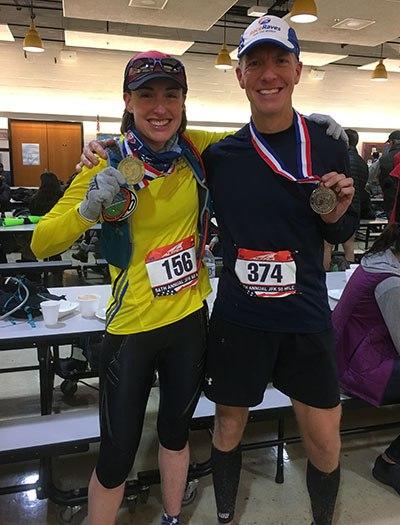
Meeting 50 Stater Meg for the first time was a highlight… congrats and well done, Meg!
Jared Hazen of Flagstaff, Arizona had been the first runner across the finish line in a mind-boggling time of 5:34:21, the second-fastest time in the event’s 56-year history. And though I’m the first to admit I’m not an elite athlete, still it boggles my mind to think any human could have run that course nearly five hours faster than I had. To give you a better sense for the impact of the course conditions, I finished in 297th place overall, whereas the 297th place finisher one year earlier had clocked a time of 10:01:10, over 23 minutes speedier.
And in a stark example of ultrarunning’s cruel streak, the course’s most loyal supporter would ultimately become its most heartbreaking casualty. Kim Byron, 63, fell short in his attempt to become the event’s first 50-time finisher. It’s safe to say we’ll all be rooting for Kim next year.
So in the end, I’d failed to eclipse my 50+ mile personal record set at the 56-mile Comrades Marathon five months earlier. Heck, never mind the PR — I hadn’t even broken ten hours. But on the bright side (because there’s always a bright side), I’d done enough nutrition-wise along the way to fuel me consistently throughout the race, without any of the issues I’d experienced at Comrades.
My real enemy on this day hadn’t been my stomach for a change, but rather my quads. Thanks to all the mud, the muscles in my upper legs felt like they’d just gone 12 rounds with a young Mike Tyson. And like so many other proud fighters who had, they’d thrown in the towel early — only this time their stubborn corner had refused to stop the fight.
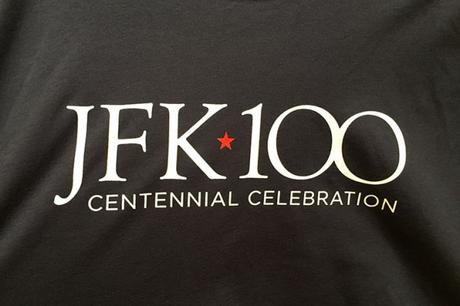
My quads nearly seceded at the thought, until I realized this was in celebration of his 100th birthday in 2017
I came away from this race thinking four 50+ milers in 18 months was more than enough, and that maybe it was time to scale back a bit. Sure, conventional ultrarunning wisdom dictates that I take the next step up to 100K or even 100 miles, but I have no desire — I know I could persevere through 100 miles, but what’s the point? I’d much rather speed up again than slow down further, because I still believe it’s more difficult to run a fast marathon than a slow 100 miles. And I have no desire at this point to become an ultrahiker. I can see myself potentially stretching for 100K (and I have just the race in mind), but 100 miles ain’t happening anytime soon. Though if I’ve learned one thing in my running career, it’s that I should never say never.
The next morning we bid Hagerstown goodbye and hit the road for Bethesda to visit friends, having added a patriotic 24th chapter to my 50 States memoir. As a participant in what JFK once termed “the vigorous life,” I’d accepted one of our nation’s preeminent challenges and prevailed in conditions that would have made even Teddy Roosevelt and his Marines proud.
And the rest, as they say, is history.
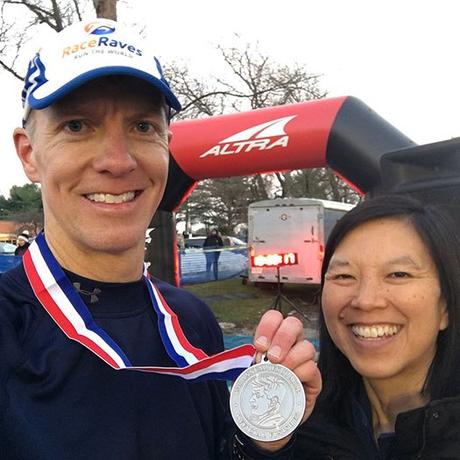
BOTTOM LINE:
First held in 1963 during the Kennedy administration, the JFK 50 Mile is the country’s oldest and largest ultra marathon. It’s an iconic race that draws some of the country’s most elite runners, as well as folks like me. The event remains a military race at heart with its most prestigious award, the Kennedy Cup, being awarded to its top military team. Buoyed by 56 years of history, this is a must-run race for serious ultrarunners, one that inspires fierce loyalty among its finishers — case in point Kimball Byron, who sadly fell short this year in his attempt to become the event’s first 50-time finisher. With limited elevation change after the first 16 miles, this is also a great option for anyone looking to tackle their first 50-miler.
The JFK 50 course is part road (paved), part trail (unpaved). About 80% of the course runs on the unpaved Appalachian Trail and C&O Canal Towpath, with the paved 20% coming at the beginning and end. The course is divided into three main sections, starting with the Appalachian Trail (~11 of the first 16 miles) and moving on to the unpaved/crushed gravel C&O Canal Towpath (26 miles) before finishing on paved, rolling country roads (8 miles). The good news is you’ll get through the toughest section of the course (i.e. the Appalachian Trail) at the beginning; the bad news is that the hills and highly technical terrain will sap a lot of the energy and bounce from your legs. This was especially true in 2018, when record annual rainfall and eight inches of snow less than 36 hours earlier created trail conditions that were, according to one 31-time finisher, “the worst ever.” So my recommendation would be to prepare for the worst and then be pleasantly surprised if/when you luck into dry (or at least not marshy) trail conditions.
Despite having four 50+ milers under my belt, this was the first race where I can recall feeling bored for long stretches, particularly on the flat 26-mile C&O Canal Towpath along the Potomac River where the scenery never changed. As one RaceRaves reviewer put it, it was like the running version of Groundhog’s Day. With no hills, no change of scenery and no headphones allowed on the course, I spent much of the middle 26 miles in my own head trying to focus on something other than my heavy quads and mounting fatigue, while slowly ticking off the miles one… at… a… time. If not for having to negotiate frequent mud puddles, I could have run this entire stretch on autopilot.
So although I’d be curious to take another crack at this course under drier conditions, given that we live 2,500 miles away and I still have 26 states remaining, I won’t be returning for a rematch anytime soon. Someday, maybe…
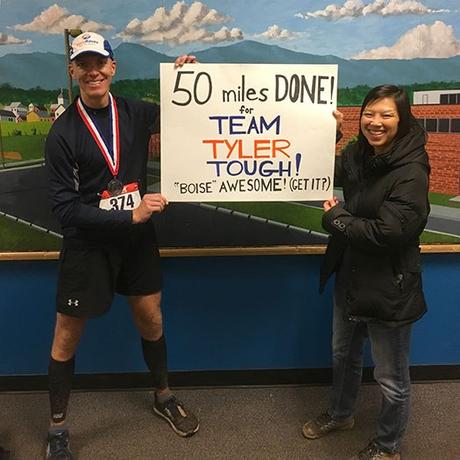
Inspiration is a tough-as-nails 14-year-old in the fight of his life against an insidious disease (and yes, Tyler lives in Idaho)
PRODUCTION:
Race day was a smooth production for the most part. Aid stations were well stocked (which for me means peanut butter & jelly along with bananas), though I could feel my insulin levels spike just surveying the amount of cookies and sugary foods available. And the outstanding volunteers were ready to assist with pretty much anything you’d want or need, from food to Vaseline to good old-fashioned encouragement. As is the case with most events and especially the best ones, the JFK 50 doesn’t happen without the tireless support of its volunteers who sacrifice their day so the rest of us can chase our goals and play in the mud.
Conveniently held at the host hotel (the Homewood Suites by Hilton Hagerstown), the race expo was your typical low-key ultramarathon packet pickup with tables from Altra Running (the presenting sponsor), a local running store and the JFK 50 folks themselves selling race merch past and present. The organizers even created a cool booklet featuring statistics from past JFK 50 finishers and course record holders plus a detailed rundown of historical sites along the course, very few of which you’ll be able to appreciate on race day.
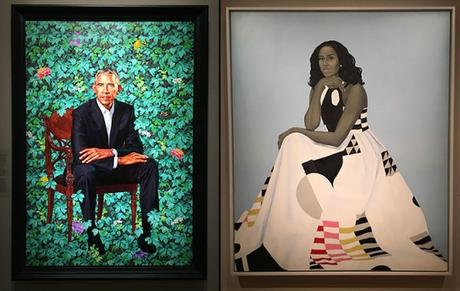
We even managed a post-race visit to the National Portrait Gallery
The post-race spread in the Springfield Middle School cafeteria was low-key but fairly generous including pizza, chili (Sloppy Joe or chili cheese dog, anyone?) and assorted aid station snacks such as pretzels, M&Ms and red velvet cake. Massages were also available for those who were willing to freshen up first. Most importantly for me, the indoor cafeteria offered a warm place to sit and recover while reveling in the accomplishment of another 50-mile run.
I’d recommend to the organizers that the pre-race briefing begin (or end) five minutes earlier, to allow for last-minute porta-potty stops before the race start. By the time I exited the crowded gym after the briefing, took care of business and then walked briskly to the start line, the starter’s pistol had already fired and I was among the last runners to start. Not a terrible thing except the JFK 50 has no chip timing at the start, so the clock started while I was still ¼ mile behind the line in my wind pants and jacket. Oops.
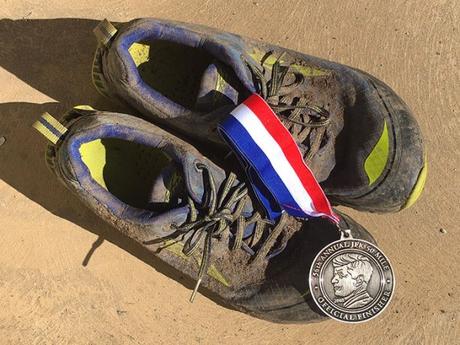
SWAG:
From what I can tell, the JFK 50 finisher medal never changes aside from the year because similar to Comrades, why fix what ain’t broke? The iconic award is a silver- (or gold)-colored medal depicting JFK in profile, reminiscent of (but larger than) the half dollar coin that bears his likeness. The medal hangs from a patriotic red, white and blue ribbon. Like many trail races, the shirt is a simple cotton short-sleeve tee featuring the race’s patriotic logo on front with sponsors listed on back. And though I have no shortage of race tees, I’ll happily wear this one if for no other reason than its promise as a conversation starter.
Updated 50 States Map:
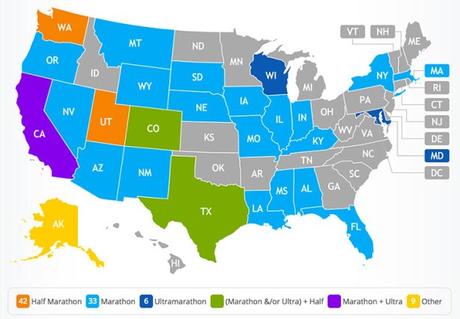
RaceRaves rating: 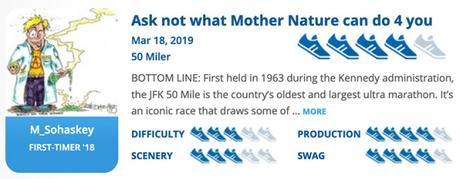
FINAL STATS:
Nov 17, 2018 (start time 6:30 am, sunrise 6:57 am)
50.94 miles (includes ~0.2 miles extra due to starting behind start line) from Boonsboro to Williamsport, MD (state 24 of 50)
Finish time & pace: 10:24:33 (first time running the JFK 50), 12:14/mile
Moving time & pace: 10:07:55, 11:56/mile
Finish place: 297 overall, 82/208 in M 40-49 age group
Number of finishers: 762 (591 men, 171 women); 868 starters (663 men, 205 women)
Race weather: cold (39°F) & partly cloud at the start & finish, overcast throughout the race
Elevation change (Garmin Connect): 2,862 ft gain, 2,953 ft loss
Elevation min, max: 239 ft, 1,749 ft
